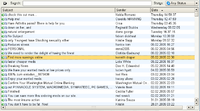Many businesses rely on automated spam filters to their detriment. Unwanted contact in any form — regular mail, email or telephone — can be a nuisance, but email is the device we can use that automatically screens out items we may not want.
Spam filters are imperfect, however, and you use them without verification at your own peril. Any automatic filter, even ones that forward mail from a specific address to another address or directory, should be regularly tested and checked.
We’ve seen too many incidents where small businesses have used a contact form that was configured years ago, but new spam filtering technology is picking up certain words or the absence of them to filter the results. That means that a lead with just a phone number or email may end up in a spam filter.
Today’s experience in our office underscored this issue more than any anecdote you might hear. We wrote Google AdWords this weekend with two questions. They weren’t complex, but they needed a Googler to respond. Unfortunately, the response ended up in a spam filter. That might not be so bad, but the irony is that we use Gmail.
Google’s own mail program flagged mail from the company. I freely admit that had I written an email client that there would be an exception for my own mail, but it’s smart for Google not to do so, any more than the company should stop showing Yahoo! local information in its own search results.
But your important takeaway is to regularly scan your email spam and other boxes, remembering that most automatically delete mail after a certain amount of time, usually 30 days.

![Reblog this post [with Zemanta]](https://s25371.pcdn.co/wp-content/uploads/reblog_a11.png)